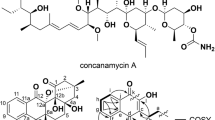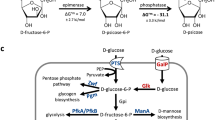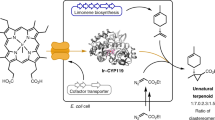Abstract
The efficient production of the textile dye indigo by fermentation has been a goal since the early 1980's when the first bacterial strains capable of this synthesis were constructed. We report here the development of a recombinant microorganism that directly synthesizes indigo from glucose. This construction involved the cloning and genetic manipulation of at least 9 genes and modifications of the fermentation medium to help stabilize the biosynthetic activity. Directed genetic changes in two operons caused significant increases in reaction rates and in the stability of the catalytic enzymes. This example of whole cell catalysis by a recombinant Escherichia coli represents a novel and environmentally sound approach to the synthesis of a high value specialty chemical.
This is a preview of subscription content, access via your institution
Access options
Subscribe to this journal
Receive 12 print issues and online access
$209.00 per year
only $17.42 per issue
Buy this article
- Purchase on Springer Link
- Instant access to full article PDF
Prices may be subject to local taxes which are calculated during checkout
Similar content being viewed by others
References
Nagahari, K., Tanaka, P., Hishimura, F., Kuroda, M. and Sakaguchi, K. 1977. Control of tryptophan synthetase amplified by varying the number of composite plasmids in Escherichia coli Cells. Gene 1: 141–148.
Mascarenhas, D. 1987. Tryptophan-producing microorganism. International patent WO87/01130.
Rood, I., Sneddon, M. and Morrison, J. 1980. Instability in tyrR strains of plasmids carrying the tyrosine operon: isolation and characterization of plasmid derivatives with insertions or deletions. J. Bacteriol. 14: 552–557.
Anderson, S., Marks, C.B., Lazarus, R., Miller, J., Stafford, K., Seymour, J., Light, D., Rastetter, W. and Estell, D. 1985. Production of 2-keto-L-gulonate: an intermediate in L-ascorbate synthesis by a genetically modified Erwinia herbicola. Science 230: 144–149.
Grindley, J.F., Peyton, M.A., VanDepol, H. and Hardy, K.G. 1988. Conversion of glucose to 2-keto-L-gulonate: an intermediate in L-ascorbate synthesis by a recombinant strain of Erwinia citrius. Appl. and Environ. Microbiol. 54: 1770–1775.
Fisher, E.F. 1985. System for biotin synthesis. International patent WO87/01391.
Isogai, T., Fukagawa, M., Aramuri, I., Iwami, M., Kojo, H., Ono, T., Ueda, Y., Kohsaka, M. and Imanaka, H. 1991. Construction of a 7-aminocephalosporanic acid (7ACA) biosynthetic operon and direct production of 7ACA in Acremonium chrysogenum. Bio/Technology 9: 188–191.
Ensley, B.D., Ratzkin, B.J., Osslund, T.D., Simon, M.J., Wackett, L.P. and Gibson, D.T. 1983. Expression of naphthalene oxidation genes in Escherichia coli results in the biosynthesis of indigo. Science 222: 167–169.
Ensley, B.D., Osslund, T.P., Joyce, M. and Simon, M.J. 1988. Expression and complementation of naphthalene dioxygenase activity in Escherichia coli, p. 437–455. In: Microbial Metabolism and the Carbon Cycle. Hagedorn, S. R., Hanson, R. S. and Kunz D. A. (Eds. ). Harwood Academic Publishers, NY.
Serdar, C., Murdock, D. and Rhode, M.F. 1989. Parathion hydrolase gene from Pseudomonas diminuta MG. Bio/Technology 7: 1151–1155.
Fieschko, J. and Ritch, T. 1985. Production of human alpha consensus interferon in recombinant Escherichia coli. Chem. Eng. Commun. 45: 229–240.
Haigler, B.E. and Gibson, D.T. 1990. Purification and properties of ferredoxinNAP, a component of naphthalene dioxygenase from Pseudomonas sp. strain NCIB 9816. J. Bacteriol. 172: 465–468.
Ensley, B.D., Gibson, D.T. and Laborde, A.L. 1982. Oxidation of naphthalene by a multicomponent enzyme system from Pseudomonas sp. strain NCIB 9816. J. Bacteriol. 149: 948–954.
Haigler, B.E. and Gibson, D.T. 1990. Purification and properties of NADH-ferredoxinNAP reductase, a component of naphthalene dioxygenase from Pseudomonas sp. strain NCIB 9816. J. Bacteriol. 172: 457–464.
Ensley, B.D. and Gibson, D.T. 1983. Naphthalene dioxygenase: purification and properties of a terminal oxygenase component. J. Bacteriol. 155: 505–511.
Vieira, J. and Messing, J. 1982. The PUC plasmids and M13 mp7-derived system for insertion mutagenesis and sequencing with synthetic universal primers. Gene 19: 259–268.
Morrice, N., Geary, P., Cammack, R., Harris, A., Beg, F. and Aitken, A. 1988. Primary structure of protein B from Pseudomonas putida, member of a new class of 2Fe-2S ferredoxins. Fed. Europ. Biochem. Soc. 231: 336–340.
Zylstra, G.J. and Gibson, D.T. 1989. Toluene degradation by Pseudomonas putida F1. J. Biol. Chem. 264: 14940–14945.
Kurkela, S., Lehvaslaiho, H., Palva, E.T. and Teeri, T.H. 1988. Cloning, nucleotide sequence and characterization of genes encoding naphthalene dioxygenase of Pseudomonas putida strain NCIB 9816. Gene 73: 355–362.
Pukuyama, K., Nakamura, M., Katsube, Y., Tanaka, N., Kakudo, M., Wada, K., Hase, T. and Matsubara, H. 1981. X-ray analysis of a [2fe-2s] ferredoxin from Spirulina platensis: main chain fold and location of side chains at 2.5å resolution. J. Biochem. 90: 1763–1773.
Howard, J.B., Lorsbach, T.W., Eliosh, D., Melis, K. and Stout, C.D. 1983. Structure of Azotobacter vinelandii 7fe ferredoxin: amino acid sequence and electron density maps of residues. J. Biol. Chem. 256: 508–522.
Elliott, J.I., Yang, S.S., Ljungdahl, L.G., Trans, J. and Reilly, C.F. 1982. Complete amino acid sequence of the 4fe-4s thermostable ferredoxin from Clostridium thermoaceticum. Biochemistry 21: 3294–3298.
Housinger, R.P., Moura, I., Jemoura, J., Xavier, A.V., Heiena Santos, M., Legall, J. and Howard, J.B. 1982. Amino acid sequence of a 3fe:3s ferredoxin from the “Archaebacterium” Methanosarcina barkeri (DSM 800). J. Biol. Chem. 257: 14192–14197.
Reith, M.E., Laudenbach, D.E. and Straus, N.A. 1986. Isolation and nucleotide sequence analysis of the ferredoxin I gene from the cyanobacterium Anacystis nidulans R2. J. Bacteriol. 168: 1319–1324.
Chan, T.M., Hermodson, M.A., Ulrich, E.L. and Markley, J.L. 1983. Nuclear magnetic resonance studies of 2fe-2s ferredoxins: determination of the sequence of Anabaena variabilis ferredoxin II, assignment of aromatic resonances in proron spectra and effects of chemical modifications. Biochem, 22: 5988–5995.
Minami, Y., Wakabayashi, S., Imoto, S., Ohta, Y. and Matsubara, H. 1985. Ferredoxin from a liverwort, Marchantia polymorpha: purification and amino acid sequence. J. Biochem. 98: 649–655.
Minami, Y., Wakabayshi, S., Yamada, F., Wada, K., Gzumet, W. and Matsubara, H. 1984. Ferredoxins from the photosynthetic purple non-sulfur bacterium Rhodopseudomonas palustris: Isolation and amino acid sequence of ferredoxin I. J. Biochem. 96: 585–592.
Gurbiel, R.J., Batie, C.J., Sivaraja, M., True, A.E., Fee, J.A., Hoffman, B.M. and Ballou, D.P. 1989. Electron-nuclear double resonance spectroscopy of 15N-enriched phthalate dioxygenase from Pseudomonas cepacia proves that two histidines are coordinated to the [2Fe-2S] rieske-lype clusters. Biochem. 28: 4861–4871.
Cline, J.F., Hoffman, B.M., Mims, W.B., Lahaie, E., Ballou, D.P. and Fee, J.A. 1986. Evidence for N coordination to Fe [2Fe-2S] clusters of Thermus rieske protein and phthalate dioxygenase from Pseudomonas. J. Biol. Chem. 260: 3251–3254.
Yanofsky, C. 1987. Tryptophan synthetase: its charmed history. Bioessays 6: 133–137.
Ensley, B.D. 1984. Construction of synthetic operons for the microbial biosyn thesis of indigo. The World Biotechnology Report 2: 441–450.
Yanofsky, C. and Crawford, I.P. 1972. Tryptophan synthetase, p. 1–31. In: The Enzymes. 3rd Ed. Boyer, P. D. (Ed). Academic Press, New York.
Miles, E.W., Kawasaki, H., Ahmed, S.A., Morita, H. and Nagata, S. 1989. The beta subunit of tryplophan synthetase. Clarification of the roles of histidine 86, lysine 87, arginine 148, cystine 170, and cysteine 230. J. Biol. Chem. 264: 6280–6287.
Cotton, R. and Crawford, G.H. and I.P. 1972. Tryptophan synthetase β2 subunit applications of genetic analysis to the study of primary structure. J. Biol. Chem. 247: 1853–1891.
Hyde, C.C., Ahmed, S.A., Padlan, E.A., Miles, E.W. and Davies, D.R. 1988. Three-dimensional structure of the tryptophan synthetase α2β2 multienzyme complex from Salmonella typhimurium. J. Biol. Chem. 263: 17857–17871.
Hyde, C.C. and Miles, E.W. 1990. The tryptophan synthetase multienzyme complex: exploring the structure function relationships with X-ray crystallography and mutagenesis. Bio/Technology 8 27–32.
Starr, M.P., Blau, W. and Kossens, G. 1960. The blue pigment of Pseudomonas lemonnieri. Biochem. Zeits. 333: 328–334.
Oshiman, T., Kawai, S. and Egami, F. 1965. Oxidation of indole to indigotin by Pseudomonas indoloxidans. J. Biochem. 58: 259–263.
Caruthers, M.H. 1982. Chemical synthesis of DNA, p. 71–79. In: Chemical and Enzymatic Synthesis of Gene Fragments. Gassen, H. G. and Langs, A. (Eds. ). Verlag Chemie, Weinheim, FRG.
Maniatis, T., Fritsch, E.F. and Sambrook, J. 1989. Molecular Cloning, A Laboratory Manual. Cold Spring Harbor Laboratory Press, NY.
Author information
Authors and Affiliations
Rights and permissions
About this article
Cite this article
Murdock, D., Ensley, B., Serdar, C. et al. Construction of Metabolic Operons Catalyzing the De Novo Biosynthesis of Indigo in Escherichia coli. Nat Biotechnol 11, 381–386 (1993). https://doi.org/10.1038/nbt0393-381
Received:
Accepted:
Issue Date:
DOI: https://doi.org/10.1038/nbt0393-381
This article is cited by
-
Indigo production goes green: a review on opportunities and challenges of fermentative production
World Journal of Microbiology and Biotechnology (2024)
-
Production of indigo by recombinant bacteria
Bioresources and Bioprocessing (2023)
-
Development and optimization of a microbial co-culture system for heterologous indigo biosynthesis
Microbial Cell Factories (2021)
-
An overview of microbial indigo-forming enzymes
Applied Microbiology and Biotechnology (2020)
-
Application of an efficient indole oxygenase system from Cupriavidus sp. SHE for indigo production
Bioprocess and Biosystems Engineering (2019)



